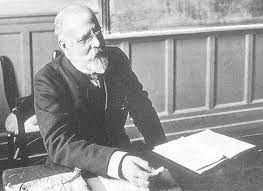
Charles-Jean-Melchior, Marquis de Vogüé was a French archaeologist, diplomat, and member of the Académie française in seat 18.

Charles Simon Clermont-Ganneau was a noted French Orientalist and archaeologist.

The Temple of Eshmun is an ancient place of worship dedicated to Eshmun, the Phoenician god of healing. It is located near the Awali river, 2 kilometres (1.2 mi) northeast of Sidon in southwestern Lebanon. The site was occupied from the 7th century BC to the 8th century AD, suggesting an integrated relationship with the nearby city of Sidon. Although originally constructed by Sidonian king Eshmunazar II in the Achaemenid era to celebrate the city's recovered wealth and stature, the temple complex was greatly expanded by Bodashtart, Yatonmilk and later monarchs. Because the continued expansion spanned many centuries of alternating independence and foreign hegemony, the sanctuary features a wealth of different architectural and decorative styles and influences.

Eshmunazar II was the Phoenician king of Sidon. He was the grandson of Eshmunazar I, and a vassal king of the Persian Achaemenid Empire. Eshmunazar II succeeded his father Tabnit I who ruled for a short time and died before the birth of his son. Tabnit I was succeeded by his sister-wife Amoashtart who ruled alone until Eshmunazar II's birth, and then acted as his regent until the time he would have reached majority. Eshmunazar II died prematurely at the age of 14. He was succeeded by his cousin Bodashtart.

Bodashtart was a Phoenician ruler, who reigned as King of Sidon, the grandson of King Eshmunazar I, and a vassal of the Achaemenid Empire. He succeeded his cousin Eshmunazar II to the throne of Sidon, and scholars believe that he was succeeded by his son and proclaimed heir Yatonmilk.

The Byblian royal inscriptions are five inscriptions from Byblos written in an early type of Phoenician script, in the order of some of the kings of Byblos, all of which were discovered in the early 20th century.
The Thrones of Astarte are approximately a dozen ex-voto "cherubim" thrones found in ancient Phoenician temples in Lebanon, in particular in areas around Sidon, Tyre and Umm al-Amad. Many of the thrones are similarly styled, flanked by cherubim-headed winged lions on either side. Images of the thrones are found in Phoenician sites around the Mediterranean, including an ivory plaque from Tel Megiddo (Israel), a relief from Hadrumetum (Tunisia) and a scarab from Tharros (Italy).

The Corpus Inscriptionum Semiticarum is a collection of ancient inscriptions in Semitic languages produced since the end of 2nd millennium BC until the rise of Islam. It was published in Latin. In a note recovered after his death, Ernest Renan stated that: "Of all I have done, it is the Corpus I like the most."

The Bodashtart inscriptions are a well-known group of between 22 and 24 Phoenician inscriptions from the 6th century BC referring to King Bodashtart.

The Baalshillem Temple Boy, or Ba'al Sillem Temple Boy, is a votive statue of a "temple boy" with a Phoenician inscription known as KAI 281. It was found along with a number of other votive statues of children near the canal in the Temple of Eshmun in 1963-64 by Maurice Dunand, and is currently in the National Museum of Beirut.

The Neirab steles are two 8th-century BC steles with Aramaic inscriptions found in 1891 in Al-Nayrab near Aleppo, Syria. They are currently in the Louvre. They were discovered in 1891 and acquired by Charles Simon Clermont-Ganneau for the Louvre on behalf of the Commission of the Corpus Inscriptionum Semiticarum. The steles are made of black basalt, and the inscriptions note that they were funerary steles. The inscriptions are known as KAI 225 and KAI 226.

The Abydos graffiti is Phoenician and Aramaic graffiti found on the walls of the Temple of Seti I at Abydos, Egypt. The inscriptions are known as KAI 49, CIS I 99-110 and RES 1302ff.
Eshmunazar I was a priest of Astarte and the Phoenician King of Sidon. He was the founder of his namesake dynasty, and a vassal king of the Achaemenid Empire. Eshmunazar participated in the Neo-Babylonian campaigns against Egypt under the command of either Nebuchadnezzar II or Nabonidus. The Sidonian king is mentioned in the funerary inscriptions engraved on the royal sarcophagi of his son Tabnit I and his grandson Eshmunazar II. The monarch's name is also attested in the dedicatory temple inscriptions of his other grandson, King Bodashtart.

The Abdmiskar cippus is a white marble cippus in obelisk form discovered in Sidon, Lebanon, dated to 300 BCE. Discovered in 1890 by Joseph-Ange Durighello.

The Tyre Cistern inscription is a Phoenician inscription on a white marble block discovered in the castle-palace of the Old City of Tyre, Lebanon in 1885 and acquired by Peter Julius Löytved, the Danish vice-consul in Beirut. It was the first Phoenician inscription discovered in modern times from Tyre.

The Abibaʻl Inscription is a Phoenician inscription from Byblos on the base of a throne on which a statue of Sheshonq I was placed. It is held at the Vorderasiatisches Museum Berlin.

The Umm Al-Amad votive inscription is an ex-voto Phoenician inscription of two lines. Discovered during Ernest Renan's Mission de Phénicie in 1860–61, it was the second-longest of the three inscriptions found at Umm al-Amad. All three inscriptions were found on the north side of the hill.

The Baalshamem inscription is a Phoenician inscription discovered in 1860–61 at Umm al-Amad, Lebanon, the longest of three inscriptions found there during Ernest Renan's Mission de Phénicie. All three inscriptions were found on the north side of the hill; this inscription was found in the foundation of one of the ruined houses covering the hill.
The Phoenician Adoration steles are a number of Phoenician and Punic steles depicting the adoration gesture (orans).

The Sibbolet funeral inscription is a Punic language inscription found in 1902 at Carthage. It measures 20 by 7 cm and is currently held at the Carthage National Museum. It is known as KAI 92, CIS I 5948, or R 768.

















